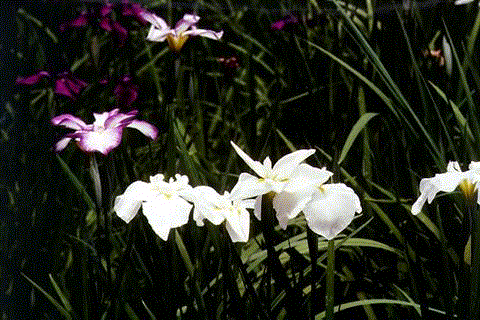Introduction
It takes around 20 minutes to Nirayama Station getting
on Izu Hakone Railway train from Mishima Station,
the starting station. On your left side in several
minutes before arrival at Nirayama Station, you will
see some interesting colourful pictures describing
Yoritomo Minamoto, the founder of Kamakura
Shogunate, and the war when he raised force to
restore Genji Clan (Minamoto Clan) about 800 years
ago. These pictures were drawn by pupils of Nirayama
Public Primary School. You will see a modern complex
of buildings of theater, reharsal rooms and the town
operating library on your left .
The town has an opera troupe consisting of amature
volunteers who live in the town and they acted an
opera of 'Yoritomo Minamoto' in 1997 for which the
audience clapped the thunders of applause.
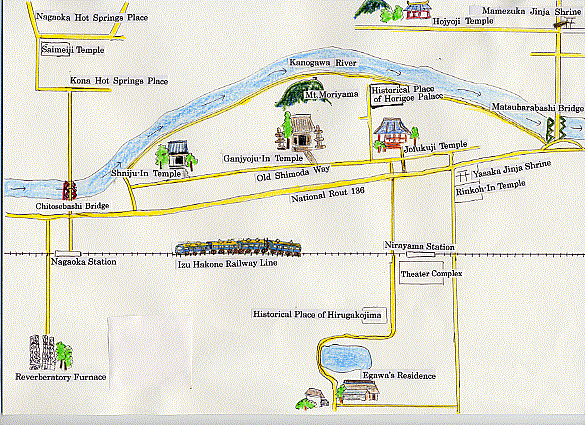 Figure 1 Map of Nirayama to Nagaoka. The cradle of Hojyo Clan who created Kamakura's Samurai culture. |
Hojyo Clan's Historical Temples
Stand Abreast Between Nirayama
and Nagaoka Along Kanogawa River
After getting off at Nirayama Station, and going out
the exit on your right side, you will see the road
crossing the railway ahead. Please turn to the left
and walk straight for a few minutes, and you will see Rinkoh-In Temple of Sohdosyu School on your right
side. As the place near here was once called "Hojyo
Village", the bus stop is now named "Hojyo".
At the corner with National Rout 136, you will see
Yasaka Jinja Shrine. When you further go straight,
you will come to a narrower way paralleling with
Rout 136. The way was once used as national
road to Shimoda which was situated in uppermost
south of Izu Peninsula.
Along this road to Shimoda, there are three historical
temples having relations with Yoritomo (1147-1199)
and Hojyo Clan who helped Yoritomo for Genji
(Minamoto Clan) Restoration but later seized the
political power from Minamoto Clan. In Shuzenji
Town, the turminal town of Izu Hakone Railway Line,
you will see the historical sad places, here and there,
of the ruin of Minamoto Clan by Hojyo's intrigue.
Another temple you should not overlook in Nirayama
is Hojoji Temple which stands beyond Kanogawa River.
After passing Matsubarab Bashi Bridge, please go to
straight, turn to the left at the cross where you will
see a small shrine called Mamezuka Jinjya Shrine
at the right opposite corner, and you will soon come
to Hojyoji Temple.
Masamune, Son of Tokimune Built
Jofukuji Temple As Hojyo Clan's
Temple
These temples have kept enough treasures for
making sightseers be able to imagin well the stories
800 years ago. Let's commence Jofukuji Temple of
Johdo Shinshu School. When you enter the gate,
you will find the explanation board in Japanese
writing the "Connection with Hojyo Clan" as the
following:
| Connection of Jofukuji Temple with Hojyo Clan Masamune Hojyo, the second son of The Eighth Aid to Shogun built the temple in 1289 to carry out his father's wishes, when he came back here from Kamakura. The temple belongs to Ohtani School of Johdo Shinshu now, and its head temple is Higashi Honganji Temple in Kyoto. Jofukuji Temple is dedicated to Amitabha. It is said that the temple was built in the place where once Jibutsudoh (Buddha House) and the governing office stood in which Tokiiye and Tokikata Taira, the ancestors of Hojyo Clan had worked as then government's officer in Heian Era. They were descendants of Emperor Kammu. The temple holds a mass for the war dead of 160,000 including both Japanese and Mongols when battling in Kamakura Era. Tokimune Hojyo, the Eighth Aid to Shogun made his first son Sadatoki donate 1,000 "Jizoes" (guardian deities of children) and made his second son Masamune donate transcription of "Issai-Kyo ( Sutra). Masamune asked Joshin Holy Priest, Superior the Second of Honganji Temple to teach him, and Joshin accepted it. Later in Kamakura, a great mourning mass for the war dead was held by high learned priests group who came throughout the country. After mastered Joshin's doctorin, Masamune traveled to propagate the thought of praying to Amitabha (the thought that one can go to paradise after his or her death, if one pray to Amitabha). Jofukuji Temple is Hojyo Clan's family temple After his father Tokimune died, Masamune left Kamakura, built this temple, and built graves of his parents under which he buried a part of their bones brought from Kamakura. He also built a grave of succsessive generations of Hojyo Clan here. Relation with Sohun Hojyo Sohun Hojyo who came to Nirayama and built a castle on a hill to live there helped the temple, and his grandchild Ujiyasu gave a certification document and supported that priests of Jofukuji Temple for going Honganji Temple in Osaka. Descendants of Hojyo Clan keep the temple even today. The survey of the historical relics here is cralifying the historical facts. I Pray Resident Priest Shumon Hojyo |
Moritoki Hojyo was acting the last role of the position
as 16th Aid to Shogun in Kamakura Era but the real
political power was held by retired Takatoki who
had acted 14th Aid to Shogun and entered priesthood.
Since Yoritomo restored Genji Clan (Minamoto Clan)
and established Kamakura Shogunate in 1192, the era
had lasted about 140 years. As I wrote in Part 2
Shuzenji Town, the restored Genji Clan had continued
for only 27 years, because Yoritomo was abnormally
suspicious to others and killed even his younger
brothers Noriyori and Yoshitsune who established
brilliant military services in the restoration war against
Heike Clan (Taira Clan).
Tokimasa Hojyo, father of Yoritomo's wife, Masako
Hojyo wickedly assasinated his two grandchildren
Yoriiye and Sanetomo. Tokimasa invited a prince of
then emperor from Kyoto to make him sit the chair of
puppet Shogun and he began Hojyo Clan's governing
Japan.
Yoritomo chose Kamakura as Samurai's capital,
because the place is surrounded by moutains except
seaside. Kamakura was considered to be natural
unapproachable place as a impregnable city.
Nevertheless Kamakra was fraillily sank when
Yoshisada Nitta atacked the city along the west
sea coast in 1333, who headed his own miritaly force
which participated in Emperor Godaigo's plan to
recover the political power and to begin governing
this country by emperor again.
In this war Takatoki and all of Hojyo Family menbers
committed suicide with sword together with their
close retainers at Keishoji Temple, and Hojyo Clan
ruined.The men and women who died at the temple
was about 800. I was taught this story in my boyhood
in junior high school. To tell the truth, however, the
explanation board written by Resident Priest Shumon
Hojyo means that the descendants of Masamune
Hojyo have lived successively in Nirayama until today.
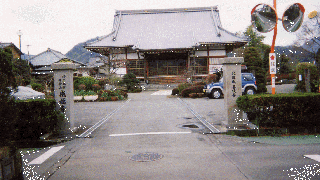 |
Figure 2 Jofukuji, the Hojyo Clan's temple |
| Figure 3 Tokimune Hojyo, his son Masamune and Masamune's wife sleep under these three graves. |
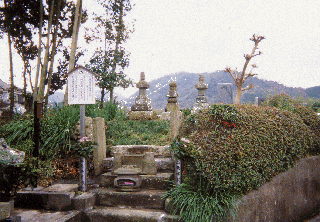 |
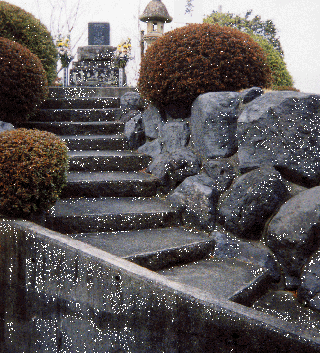 |
Figure 4 The grave burys successive generations of Hojyo Family. |
Big Typhoons Rescued National Crises By Mongol In 1274 And 1281
In Asian Continent, Qubilai, grandchild of Chinggis
Khan who established Mongol Imperial Yuan, was
expanding his dominant power. He wanted to trade
with Japan and dispatched his missions five times
for seven years but he could not receive even an
answer. He made his mind to attack Japan and
made Yuan's subject nation Kao-li (Korea) build
900 ships.
In Kamakura Shogunate the political power was
consisting of a group decision meeting headed by
Hojyo Clan's representative, namely Aid to
Shogun. Then Eighth Aid to Shogun was Tokimune
Hojyo. Hojyo Clan was heading less than ten other
influential clans to make follow but contentions
among them often happened and sometime a
rebellion had to be repressed by Hojyo Clan.
It was in 1274 that an allied forces of Yuan and
Kao-li of 25,000 warriors attacked Oki and Tsusima
Islands. Then Eighth Aid to Shogun, Tokimune Hojyo
(1250-1284) was so young as 22 years old.
At that time, Japan's way of battle was to sword-to
-sword fight between a strong men of both ally and
enemy in the midst of their confront. In Heike
Monogatari Story describing the battles between
Heike (Taira Clan) and Genji (Minamoto Clan),
Yoichi Nasu of Genji force who was an expert of
bowing was applauded by the enemy, when he shot
down a manual fan raised on a ship of Heike force.
To the contrary, Mongol way of battle was to
mercilessly shoot countless arrows like rain on
enemy from warriors of horseback. On top of this,
the arrows used by Japanese force could not
phisically reached to long distance, partly as they
were long, while short ones of Mongol force could.
Beside the fact, Mongols painted poison on their
arrows.
Mongol force, first of all, went ashore on Oki and
Tsusima Islands on foot and Japanese force of
Samurais on horseback and the dwellors were
all killed in the battle. Mongol force was triumphantly
went ashore on Hakata, the north end of Kyushu.
They used to return to their warships at night to
sleep. A big tyhoon overtook the country, and Mongol
force were totally destroyed.
In 1281 five years after the first battle, Mongol force
consisting of 140,000 warriors including 10,000
Kao-lis attacked Japan en masse. Except the Allied
Force which went ashore on Europe in The World
War The Second, no historical events other than
such a big force marched on one nation.
The biggest invading force in the global history
arrived first at Hirato Island and Gotoh Islands
near by Kyushu. In order to defend the secnd
attack, Kamakura Shogunate had built wall of
20 kilo meters length along the coast of Hakata.
In Nara (500-800 AD) and Heian (800-1200) Eras,
there were emperors, retired emperors, court
nobles, and samurai clans, and they were all
taking effort to preserve their own power and to
strengthen it whenever a chance happened. In
Kamakura Era still such a circumstance had
continued but at these Mongol invasions, no
body opposed Tokimune Hojyo's decision.
The samurai clans took the tactics to sudden
attacks onto Mongol warships from their many
small boats after quiet approaching. The tactics
were succsessful, because Mongols had no
experiences of naval battles. Fortunately, a
violent tyhoon blew Japan and all the 4,000
Mongol warships were condemned to the depth
of the sea. Suenaga Takesaki, a retainer of
Hojyo Clan wrote a record of the two wars
entitled "Mongol Attacks" and it is registered
as a national treasure by Ministry of Education.
HOJYO CLAN IN THE ROLE OF
WATCHING YORITOMO
CHANGED ITS MIND TO
PATRONAGE HIM
There stand two explantion boads in front of Jofukuji
Temple and one of them writes as the following:
| The Temple's Relation With Hojyo Clan's Residence And Horigoe Palace It is said that the premises of Hojyo Clan's residence, who patronaged Yoritomo Minamoto for restoration of Genji (Minamoto) Clan and made the basis of Kamakura Shogunate spreaded wide area including Mt. Moriyama and Jofukuji Temple. In the map recording then Nirayama, you can see the names of "Gosho-no-Uchi " (Within Horigoe Palace in English), "Tsuki-Yama" (an Artificial Hill), "Naka-no-Shima" ( Middle Island), etc. And you can see marks of ramparts with clay, ditches, waterways, etc. in the premises of this temple. It is said that a new house in which Masako Hojyo, daughter of Tokimasa lived with Yoritomo Minamoto stood on this place. The way straight to east starting from this temple for Hirugakojima where banished Yoritomo by Taira Clan lived, while going to west was for the residence of Yoshitoki Hojyo, a younger brother of Masako situated on the opposite side bank of Kanogawa River. Accordingly, some historians presume this is the mark of the way called "Hojyo Street". In Muromachi Era, Shogun Yoshimasa Ashikaga dispatched his brother Masatomo in 1457 to Izu for defending Landlord Koga and Masatomo's Horigoe Palace was also situated in around Jofukuji Temple, by reusing a part of Hojyo Clan's residence. In all the premises of Hojyo's residence, fragments of earthen vessels and old tiles are excavated. |
The explanation boards tell us that Hojyo Clan
subordinated to Taira Clan, and if environment
was favorable to do so, they participated in a
force of enemy clan regardless of having
relationship with Taira or Minamoto clans,
expecting extention of its own power in every
opportunity.
In the case of Tokimasa Hojyo, he was in the
position of monitoring Yoritomo in accordance
with the order by Kiyomori Taira, then highest
power. Kiyomori also had stationed Kanetaka
Taira as the governmental officer to Izu.
Yoritomo was exiled to distant barbarous region
Izu, when his father Yoshitomo Minamoto was
defeated by Kiyomori and killed on his way
escaping to his own land in 1200. At that time,
the defeated commander and his family were
all executed to death, except when victorious
commander was merciful. In such a case,
females of a defeated family were spared their
lives for becoming a nun. But Kiyomori was so
generous that he spared Yoshitomo's sons,
Yoritomo, Noriyori and Yoshitsune, complying
with his mother's opinion to spare their lives
because of their youthfulness. Yoritomo was
thirteen years old, when he set out his first
campaign with his father to battle with Heike
(Taira) Clan.
There are few anecdotes of Yoritomo, while
many ones of Yoshitsune. But suspicious natured
Yoritomo seemed to be very handsome and
have ability as a great organizer. He succeeded
in building up the first samurai's governig system
and construct Japan's political capital in Kamakura.
He loved Yaehime, the fourth daughter of Sukechika
Itoh, when he was monitored in Izu, but changed his
mind to Masako Hojyo, the eldest daughter of
Tokimasa, when she later fell in love with Yoritomo.
The two often repeated secret meetings at Kokuseiji Temple near by Hirugakojima and he deserted
Yaehime.
Fearing Kiyomori Taira's anger, Tokimasa arranged
marriage between Masako and Kanetaka Taira, but
just on the very day of their wedding, unyielding
Masako like a restive horse disappeared to escape
to Yoritomo's place. Yoritomo and Tokimasa could
not help but select to raise an army and kill
Kanetaka. It has passed twenty years, since he was
exiled here. Yoritomo's force consisting less than
ten samurais made sudden attack on Kanetaka's
residence on a day in August 1180 of annual
Anniversary of Mishima Taisha Shrine which had
been done for three days. The defense was scarce,
as retainers of Kanetaka were absent to the shrine.
There are many flower pots of lotus of different
kinds in front of Johukiji Temple, and you can see
them in full blossom in July.
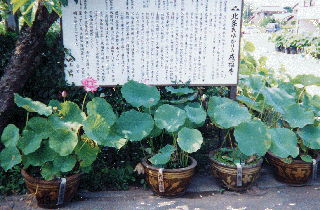 |
Figure 5 The time of blossom of lotus is July. You can see flowers of many variety of lotus species in the pots before Jyofukuji Temple. |
| Figure 6 A flower of many species of lotus. |
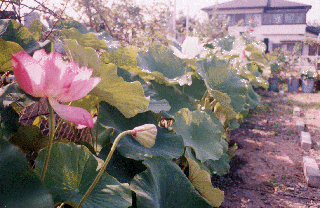 |
.
Mark of Dreaming of A High Ranked Commander "The Mark of Horigoe Palace"
When you proceed to GanJyoju-In Temple, you will
see a Map of Historical Monuments in Nirayama on
your way. If you turn to left there, you will arrive
at a vacant space with trees and grasses. The
explanacion board standing there describes it as the
following:
| Horigoe Palace The power of Muromachi Shogunate naturally declined when the eighth Shogun Yoshimasa Ashikaga was on the seat, and powerful local clans in Kantoh District which was distant from Kyoto, the capital were apt to disobey the shogunate. For alleviating this, Yoshimasa made his young brother Masatomo go to Kamakura in Choroku 2 (1458) to govern but he could not proceed there, because of the local clans' resistance. Masotomo could not but stop here, built Horigoe Palace, and waited for opportunity. Masatomo had constant trouble of his heir between his real eldest son Chachamaru and a child of wife after death of former wife. In 1491 soon after Masatomo's death due to sickness, the palace fell in disturbances, as Chachamaru killed his stepmother, his brother in law and a chief vassal. Taking advantage of the chance, Nagauji Ise Shinkuro (later Sohun Hojyo) in Kohkokuji Castle made sudden attack to kill Chachamaru. Thus Horigoe Palace which had lasted for thirty years disappeared to ash. This place was also cradleland of Hojyo Clan who exercised power as Aid to Kamakura Shogunate, accordingly old structures and relics in the end of 12th to 15th Century have been discovered by a few excavations since 1982. And at present, the place names which show the history still exist around here as "Gosansyo (meaning 'Room for Childbirth')", "Gosyo-no-Uchi ('Within Palace')", "Tsukiyama ('An Artificial Hill')",etc. March 1986 Educational Committee, Nirayama Town |
Muromachi Era Governed By Ashikaga
Clan Continued For 240 Years
Emperor Godaigo tenaciously restored political power
by dispatching Commander Yoshisada Nitta to attack
Hojyo Clan in Kamakura in 1333 and the shogunate
ruined. Yoritomo Minamoto, the founder of Japan's
first samurai's government built and established
Kamakura as political capital from scratch, thinking
the place was impregnable, because it was surrounded
with moutains and hills in east, west and north.
Commander Nitta's force, however, invaded to
Kamakura from the sea, and Takatoki Hojyo, then
highest power comitted suicide with his own sword
together with about 800 members of the clan,
retainers and lady's maids.
During his sitting on the throne for 21 years (1318-
1339), Emperor Godaigo planed twice to overthrow
Kamakura Shogunate and failured, because of leak
of the plans, and he was exiled to Oki Island in 1332.
In 1333, he had succeeded in getting out of the
island, and soon when Takauji Ashikaga who was
heading a powerful clan of Kamakura Shogunate
rebeled, and at the same time, Yoshisada Nitta
raised his force and attacked Kamakura en mass
from the sea. Kamakura Shogunate closed its 141
years dominance in whole Japan.
The government by Emperor Godaigo ended only for
3 years, as the complains among commanders who
wanted much prizes and higher positions. And more
importantly there exsited stiff strife between Prince
Morinaga and Takauji Ashikaga who gave the biggest
services to the new government.
Takauji took the effort to recover samurai's political
power again, and after the battles between the forces
serving to Emperor Godaigo and Takauji's force, he
established Muromachi Shogunate in Kyoto in 1338.
The shogunate had continued for 240 years until
Nobunaga Oda expeled the 15th Shogun Yoshiakira
Ashikaga.
The Third Shogun Yoshimittsu began to trade with
Ming and reached the golden age. He constructed the
famous gold gilded building "Kinkakuji Temple" in
Kyoto. The scheme of the shogunate was an
immitation of Kamakura Shogunate and the political
system was rather a combination of powerful land
lords centering around Shogun. When the Eighth
Shogun Yoshimasa who built the silver gilded
building "Ginkakuji Temple" was governing, the
authority of shogunate had weaken and state that
lower ones disobey higher ones were in fashon.
"Ganjyoju-In Temple", The Temple Tokimasa Hojyo Built
Returning from the historical place of Horigoe
Palace and turning to the right to Nagaoka, you will
come to Ganjyoju-In Temple which is the greatest
stand among the old temples having relations with
Hojyo Clan(See Figure 7).
This temple was built (renewed) by Tokimasa Hojyo
in 1189, as he prayed victory before his force started
to Ohu District to subjugate Fujiwara Clan by
Yoritomo's order and luckily won. According to the
temple's oral tradition, however, it was founded in 729
when governed by Emperor Shomu in Nara Era. Yoritomo
later named the temple as Ganjyoju-In (meaning
"Temple Being Attained A Pray" in English).
After built by the First Aid to Shogun Tokimasa Hojyo,
the Second Aid Yoshitoki and the Third Aid Yasutoki
had next to next built temples, towers,etc. in the vast
premises. It is said that they mimicked Kegoe Temple
in Ohu District built by Fujiwara Clan who attained
the highest prosperity in eastern north district. The
most famous temple still exsiting is Chusonji Temple
having a gold temple. In old time, when one walked in
the entrance gate of Ganjyoju-In Temple one would
see a big pond with an island being crossed by a
bridge. After walking through the bridge, one first
could proceed to reach temples and towers to
worship. Unfortunately, these buildings were burnt
down by a battle in 15th Century.
There is the grave of the First Aid to Shogun
Tokimasa Hojyo here. A small pond by the main
temple is called "Kubiarai-no-Ike" (The Pond of
Head Washing), because Chachamaru's head was
washed with its water, when Sohun Hojyo (no
relation with Hojyo Clan in Kamakura Era) suddenly attacked Horigoe Palace to its ruin. You will see the
grave of Chachamaru some steps deeper to the
bottom of a mountain there.
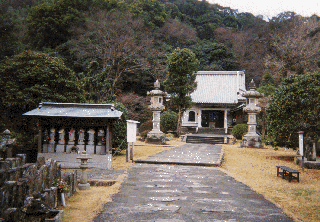 |
Figure 7 Ganjyoju-In Temple. The First Aid to Shogun Tokimasa prayed the victory for subjugating Fujiwara Clan in Eastern North District before going to battle. |
| Figure 8 The temple keeps only statue of Tokimasa. The grave burys him. |
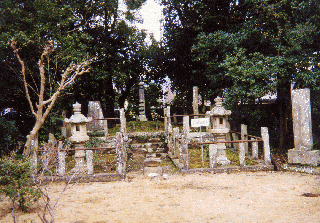 |
The explanation board in the entrance writes the
history as the following:
| Explanation Yoritomo who was the eldest son of Genji (Minamoto) Clan defeated in "Heiji-no-Ran" (Battle of Heji) in 1160. He was fourteen years old then and was exiled to Hirugakojima here. He had lived here for twenty years until he raised force. Yoritomo's father-in-law Tokimasa built this temple, thanking victory of subjugating battle against Fujiwara Clan in Ohu District and named Ganjyoju-In. Unfortunately, the temple had been burnt down by two time battles, one was attack by Sohun Ise Shinkuro and the other by Hideyoshi Toyotomi when he attacked Nirayama Castle. Accordingly, the present main temple was built in Edo Era. In Grand Temple, Statue of Amitabha Buddha as the principal image, Three Statues of Fudohson (Deities), Statue of Bisyamonten and its inner wood card with written name of sculptor are put as important exhibits. Above all, the inner card is historically rare thing proving the fact an expert sculptor of Buddha Unkei had ever went to east out of Nara. The statue of Amitabha Buddha has the artificial eyes which Unkei invented. In the premises of Ganjyoju-In Temple, there are graves of Tokimasa Hojyo and Chachamaru, Pond of Head Washing. Statue of Amitabha Buddha, Standing Statue of Fudohmyouou (Acalanatha in Sanskrit), Staue of Fudhson Konkaradohji, two Inner Cards within Fudohmyouou Bisyamonten are registered as national important cultural properties. The Superior, Ganjyoju-In Temple |
You will see a very small reception house at the
entrance of the Grand Main Temple. The entrance
fee is \300. You can see and observe these statues
close at hand.
There is treasuries behind the grand main temple in
which you can see Statue of Masako Jizo Bosatsu
(guardian deity of child bodhisattva) and Statue of
Tokimasa. The nun dressed statue of Masako which
is registered as important object of art, exhaustively
shows her unyielding character like male and
cleverness.
You will see a shrine called Moriyama Hachimangu
halfway up of Moryama mountain side behind
Ganjyoju-In Temple on your right. The shrine was
the begining place where Yoritomo watched the
residence of Kanetaka Taira bursted into flames
when he raised force to restore Genji (Minamoto)
Clan. Since then, War between Genji and Heike
(Taira) clans had continued for four years.
Shinju-In Temple Prays For
Yaehime; She Ran Away From
Home To Yoritomo, Was Refused,
And Sank In Kanogawa River
When you walk out Ganjyoju-In Temple and
proceed to Nagaoka, you will see an entering way
to go up Mt. Moriyama on your right side. At the
top of the mountain of 101.8 meters high, you
can look at 360 degree panorama scene including
beautiful Mt. Fuji, if weather is fine. In old time,
it is said that many men and women crimbed
Mt. Moriyama but now only a few are witnessed.
So I recommend you are accompanied by a few
coleagues.
After coming down the moutain and further walk
to Nagaoka, you will see a small shrine on your
right and you will arrive at Shinju-In Temple where
it prays for Yaehime in a seperate temple by the
entrance gate.
There stand two boards explaining the temple
(Sohdo-Syu, Zen-Syu) and one of them writes
Yaehime's sad story as the following:
| Here,Yaehime Itoh Sank In The River Yaehime, fourth daughter of Sukechika Itoh had lived in melancholily and she at last made her mind to run away from the annex of her father's residence to Yoritomo's place, being accompanied by six maids on July 16, Jisho 4 (1180). She gave a birth Chizumaru, as a son of Yoritomo but Chizumaru was sacrificed in the situation. She had been confined in the annex. When she arrived at a building where Yoritomo was hidden, a porter cold-broodedly refused as he knew the fact Yoritomo and Masako already fell in love. Alas as young lady Yaehime had no way of returning home, she sank herself in a rapid stream of Shinju-ga-Fuchi of Kanogawa River together with the six maids. Since then eight hundred years have passed and Kanogawa River had changed its basin. One just can see a weaken stream and imagin Yaehime's tragic love. In the premises of this temple, you will see the oldest stone tower "Five Folded Tower" (1302) in Shizuoka Prefecture, Buddha carved on a criff (1363), and others as rare historical moniments. Section of Industry & Sightseeng, Nirayama Town Keeping Group of Yaehime's Story |
What a sad story Yaehime's is! I remember a
reception old lady at Ganjyoju-In said to me,
"Some ones say 'I think Yoritomo was a lady-
killer. Yoritomo was so cold".
The board in front of Temple Praying For Yaehime
explains as the following:
| Temple Praying For Yaehime This temple prays for Yaehime Itoh who fell in love with Yoritomo and deserted, and sank herself to death in a rapid stream. In the center of the hall a wooden statue of Yaehime is enshrined and is put a massing tower under it. The huge tree is called "Nagi" at right side in front of the hall means "peace" and "gentle". As leaves of Nagi can not be torn across, it is said that if you have it as a charm, you and your family will be happy. The Stone for Desire at right side is said that if you hit it by the number of your age, your desire will visit you without fail. It is a oral tradition since old time. |
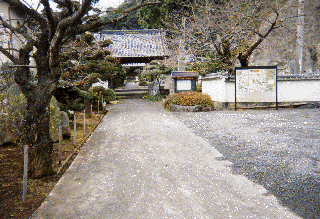 |
Figure 9 Shinju-In Temple |
| Figure 10 Yaehime who run away home to go to Yoritomo but refused, sank herself in Kanogawa River with her six maids.The temple enshrines them in a seperate temple. |
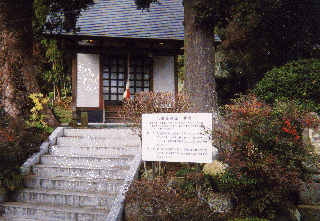 |
Hojyohji Temple Keeps Precious
Cultural Properties Hojyo Clan Left
Hojyoji Temple is situated in the deeper place from
former Shimoda Way as I refered to earlier, the
temple keeps precious cultural properties Hojyo
Clan made and left to posterity. You will find a
board of the history of the temple after entering
the gate:
| Kyotokuzan Hojyoji Temple Kencyoji Temple School, Rinzaisyu The eighth Place of 33 Spiritual Places Enshrines Statue of Kanzeon Bodhisattiva Registered by Shizuoka Prefecture The temple first was named "Kan-On-In" (Amittabha Temple in Englsih) ,as the statue of Amittabha came across the sea from China 1,200 years ago and was enshrined Ema. Tokimasa Hojyo heartfully respect Amittabha and changed the temple's name to "Hojyoji Temple". Since then his descendants had built the other temples in the premises and had donated lands too. Enshrines Statue of Amittabha Registered by Nation as A Rare Product of Art, and by Shizuoka Prefecture as A Cultural Property The art product is presumed to be a work by Unkei in Kamakura Era. When Yasuchiyo, Yoshitoki Ema Koshiroh's eldest son died by an accident of being bitten by a big snake, Yoshitoki built seven halls or temples in the premises, and he made Unkei calve the temple's principal image. This statue is called "Mu-Amidabutsu"(only one Amitabha Buddha, because there are no work by him other than this. "Botan Choh Bun Syuh"(embroidered drop curtain describing peonies and birds) Registered by Shizuoka Prefecture as Cultural Property The embroideries were donated by Yoritomo's Masako Hojyo. They were great work consisting of three embroideries describing flowers of colourful peonies, fruits trees, deer in trees and grasses, peacocks,etc. Hall Enshrined Kannon (Godess of Mercy) The temle is a building adopting the style of old time that makes you imagine what it was. Grave of Yoshitoki Hojyo See the board in front of it. Six Stone Guardian Deities of Children The roof is stone tiled. Historical Documents of Hojyoji Temple The temple keeps many old documents such as ones by Ashikaga Shogun Clan, by Different Hojyo Clan After Hojyo in Kamakura Era,etc. including ones allowing the temple and donating land. |
When you arrive at the main temple, you will find a
bell at the right side befor sliding doors. Please ring
it, and some one of the temple welcome visiters
and kindly explain the history of the treasures
to you in Japanese without collecting the fee.
The statue of Kanzeon Bodhisattiva looked so
massive to me, reflecting its annual rings of 1,200
years. The drop curtains are put in three wooden
box with a glass cover looks to be gorgeous enough,
nevertheless visitors can not take out them.
You will see a graveyard on the hill with luxuriant
trees on your left side. You can see the graves of
the Second Aid to Kamakura Shogun Yoshitoki
Hojyo and his wife with an explanation board there
saying:
| Graves of Yoshitoki Hojyo and His Wife Yoshitoki Hojyo was the second son of Tokimasa. Yoritomo Minamoto's wife Masako Hojyo was his elder sister. As he had groun up at the residence in Ema, he called himself "Yoshitoki Ema Koshiroh". He followed Yoritomo with his father Tokimasa and his brother Munetoki, since he raised force, and he gained distinguished services. After the Third Kamakura Shogun Sanetomo Minamoto was assasinated by an intrigue and Minamoto Clan's linage died out, he made Yoritsune Fujiwara, a court noble in Kyoto sit the seat of Shogun and he himself sitted the seat of Aid to Shogun. Yoritsune was a great-grand son of Yoritomo's elder sister. As Yoshitoki himself very much wielded power, Former Emperor Gotoba got anger and issued a message from the throne to subjugate Yoshitoki in Shokyu 3 (1221). Yoshitoki made his son Yasutoki and his young brother Tokifusa attack up Kyoto by heading a big force and beated. He abolished then Emperor and exiled three Former Emperors Gotoba, Juntoku and Tsuchimikado to Sado, Oki and Tsushima Ilands. This event later had been called "Shokyuh-no-Hen"(Disturbance of Shokyuh). Yoshitoki suddenly died three years after the disturbance, when he was 62 years old. His eldest son and others built Yasutoki's grave here. |
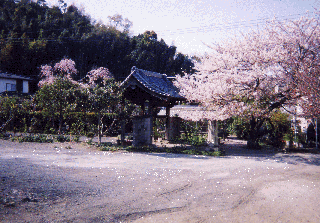 |
Figure 11 The entrance gate of Hojyoji Temple. |
| Figure 12 These two graves burys Yasutoki Hojyo and his wife. |
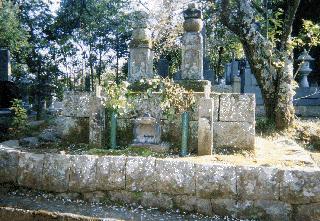 |
Tarozaemon Egawa, Great
Character At The End Of Edo Era
Now let me write about the historical places in the
opposit side of Izu Hakone Railway. There are two
historical places of Tarozaemon Egawa who acted
Governmental Officer of Tokugawa (Edo) Shogunate.
One is a reverberatory furnace which he built,
the other is his residence.
Getting off the train for Shuzenji at Nirayama
Station and walk out the wicket, you will see a sign
showing the way to a newly paved road leading to
Egawa's residence and Hirugakojima where once
Yoritomo was exiled 800 years ago. Cross the
railway and proceed the fine road for about fifteen
to twenty minuts. Then you will see the historical
monument of Hirugakojima on your right side, where Yoritomo was inprisoned
for seventeen years,
being monitored by Taira Clan.
Hirugakojima was one of the middle sandbanks
in great Kanogawa River, where leeches were living.
Tokimasa Hojyo who was heading a strong clan in
this district was taking role of monitoring Yoritomo
together with Kanetaka Taira who acted Taira
Clan's officer to Izu. However the trouble began
with his daughter Masako. As she fell in love with
Yoritomo, Tokimasa could not help but making
Yoritomo privately live in his own residence. Just
when Yoritomo did so, Yaehime Itoh ran away from
home loving Yoritomo. Torturing himself to deceive,
Tokimasa arranged the marriage of convenience
making Masako marry with Kanetaka Taira but
resitive horse Masako escaped to Yoritomo who
was kept at a distance, on the very day of wedding.
Yoritomo and Tokimasa decided to raise force,
and otherwise Kanetaka must attack them.
Yoritomo raised force and only less than ten
warriers suddenly attacked Kanetaka when many
of his retainers were absent for going to see the
annual aniversarry of Mishima Taisya Shrine.
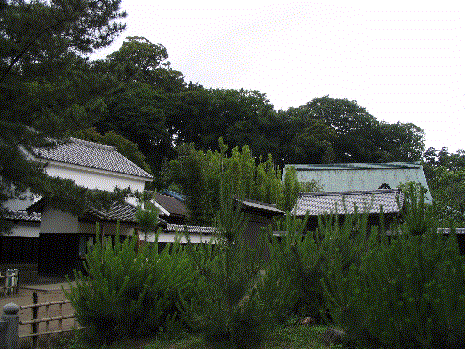 |
Figure 13 The office part of Tarozaemon Egawa's residence. In the living part the descendants are living now. |
| Figure 14 Tarozaemon Egawa who acted governmental officer to Izu at the end of Edo Era built a reverberratory furnace to produce artilleries. |
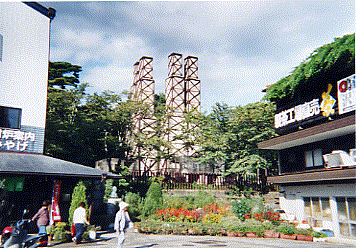 |
Egawa Did Inventions; Some Were Japan's First
When you proceed straight on the fine road, it
will lead you to a non-paved mountain-like alley.
Seeing a public primary school on your right side,
you will come to a cliff that seem to be a castle
wall. Please continue to proceed for a while and
you will suddenly see a large pond. This is Shinsui
Park before Egawa's Residence, Officer of Edo
Shogunate in Izu Region. If you go to the right,
you will arrive at the ruin site of Nirayama Castle
which Sohun Hojyo built.
In the Tarozaemon Egawa's residence, you can
not enter to the living place, as his descendants
still live. The part of wooden office building and
historical constructions were recently repaired
and recovered and are open for publick. The price
of entrance ticket is \300. And if you see the
exhibition of the town operating Nirayama Historical
Museum neibouring Egawa's residence, you will buy
a common ticket pricing \400 (for adult and \200
for child) for both buildings. In a leaflet handed at
the entrance of the residence, you will read the
sentences describing its history as the following
in short:
"Egawa Clan belonged to Seiwa Genji (Minamoto)
Clan, and its originater was Yorichika Uno who was
the second son of Mitsunaka Minamoto. Chikaharu
the sixth generation after Yorichika defeated by
participating to Former Emperor Sutoku's force at
Disturbance of Hohgen, and his grand son Chikanobu
came down to Izu accompanied by thirteen retainers.
Harunobu a son of Chikanobu participated in
Yoritomo's when he raised force in 1180. After
Genji Restoration, Yoritomo gave Chikanobu
the land in Nirayama. The thirteen retainers who
followed Chikanobu also settled in around
Kanaya near here, and their descendants have
lived until now.
Uno Clan had hardened foundation as a powerful
family here through Kamakura and Muromachi
Eras, and it changed family name to Egawa
taking the name of a branch stream of Kanogawa
River in the middle of 15th Century.
When Sohun Hojyo invaded to dominate Middle Izu
in 1493, the 23rd Hidezumi offered him a land where
Sohun built Nirayama Castle. The successive five
heads of Egawa Clan had acted Sohun's staff officer
since then. Hidenaga, the 28th became a retainer
for Iyeyasu Tokugawa, the First Shogun of Edo
Shogunate. Iyeyasu put Izu District under direct
control of the shogunate and appointed the
successive heads of Egawa Clan as govermental
officer of the shogunate".
Tarozaemon Hidetatsu Egawa (1801-1855), the 36th
was so famous as a great man of knowledge at the
end of Edo Era. According to the leaflet I refered to
earlier, he learned Dutch language, deeply knew
foreign affaires, and made a proposition to guard
national coast to the shogunate. He made the
proposition to found the system of warring and
farming and the way of its training, study of western
artiraly and its training, study of measurement and
its exsercise, building a fort called "Odaiba" in Tokyo
Bay, building a reverberatory in Nirayama, baking
Japan's first bread as food for soldiers, Japan's
first shipbuilding warship of western style in Heta
Village and its supervising, and education of
Egawa way. All were things that he had done.
When training farm soldiers, he made them sing
famous "Nohe-Bushi" singing "Fuji-no shirayukya
nohe, Asahi-de-Tokete, Tokete Nagarete nohe,
Mishima ni Sosogu" (Oh! White snow on Mt.Fuji,
Melted by the Sun-light, Oh! Melted, And Gushing
out in Mishima) to inspire them.
There are statues of two farm soldiers standing
in front of Mishima City Hall near Mishima Taisya
Shrine and it was the place where soldiers training
was done.
Nagaoka Hot Springs and Kona Hot
Springs Places
If you select to arrive at Nagaoka Station on Izu
Hakone Railway train, to get off the station, and
go straight, you will come to a corner of the
street. If you go to the right, you will walk into
the zone called "Kona Hot Springs Place". Kona
is an old hot springs place where a historical
place named "Honjin-Gensen-Ato (Honjin's
Original Hot Spring Gushing Place)" exists,
to which Yoritomo often visited to bathe in his
time of exile by Taira Clan. In the place, several
tens hotels and inns supplying hot spring
service including an inn named "Honjin". By the
way, the term "Honjin" was used to mean in old
time "a hotel some landlord stays".
New Hot Springs Place Discovered
On the other hand Nagaoka Hot Springs Place
was discovered in Meiji Era. It is situated in the
deeper zone after you turned to left at the corner
which I refered to earlier, and further turn to the
right at the first coner to come.
Larger hotels, inns than ones in Kona are operating
in Nagaoka Hot Springs Place. When one says
"Nagaoka" however, it includes both places.
Now a day, even traditional inns began to supply
"bathing hot spring only service" at very cheap
price to survive in the middst of the long deflation.
Nanzan-Soh (http://www.tokaikanko.co.jp/), for example, the traditional
and famous big inn since
Meiji Era changed its operating policy and is now
supplying "staying only"(price: \6,000 for one
person one night, \5,000 per one person for two
to three persons, and \4,500 per one person for
four to five persons) and "bathing hot spring only"
(price: \500 for one person). Nanzan-Soh now
does not offer food service except breakfirst free
(toast and coffee for visitors stayed one night ).
May 1, 2004
TO PART 1: MISHIMA CITY
TO PART 2: SHUZENJI TOWN
TO PART 3: NIRAYAMA TOWN
TO KAWAGOE CITY
TO HAGI CITY
TO PAGE SHOWING CONTENTS
YOUR IMPRESSION

